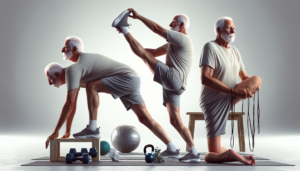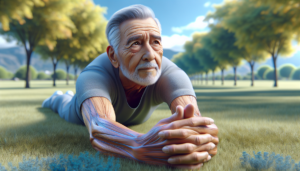Yoga Poses for Older Men
In the journey towards improving fitness and overall well-being, older men can benefit greatly from incorporating specific yoga poses tailored to their needs. Two key focuses in yoga for older men are enhancing balance and stability, as well as improving strength and flexibility.
Enhancing Balance and Stability
Balancing poses in yoga play a crucial role in enhancing stability and improving balance, which are essential components for preventing falls and maintaining mobility as we age. Incorporating poses like Balancing Mountain, Tree Pose, and Balancing Star can help older men develop a stronger sense of stability and body awareness, reducing the risk of injuries and enhancing overall physical confidence.
| Yoga Pose | Benefits |
|---|---|
| Balancing Mountain | Improves posture and core strength |
| Tree Pose | Enhances balance and focus |
| Balancing Star | Strengthens leg muscles and core stability |
These poses not only help physical well-being but also contribute to mental clarity and focus. For more balance-enhancing poses geared towards older adults, explore our article on yoga for seniors.
Improving Strength and Flexibility
Older men can also benefit from yoga poses that focus on improving strength and flexibility. Poses like Warrior 3 Variation, Dancer Pose, and Standing Twist target key muscle groups, improving overall strength, flexibility, and mobility.
| Yoga Pose | Benefits |
|---|---|
| Warrior 3 Variation | Strengthens core muscles and improves balance |
| Dancer Pose | Enhances leg strength and flexibility |
| Standing Twist | Increases spinal mobility and relieves tension |
By practicing these poses regularly, older men can build muscle strength, increase flexibility, and promote better joint mobility. Additionally, the mental focus required in these poses can help enhance cognitive function and reduce stress levels.
To delve deeper into the benefits of yoga for older men, including its positive impact on heart health and stress reduction, refer to our article on yoga benefits for older males. Incorporating a blend of poses that focus on balance, strength, and flexibility can help older men enjoy the physical and mental benefits that yoga has to offer.
Benefits of Yoga for Older Men
Taking up yoga can bring a multitude of benefits for older men, enhancing both physical and mental well-being, and aiding in the management of chronic conditions.
Physical and Mental Well-being
Yoga offers a holistic approach to well-being, catering to both the body and mind. Regular practice of yoga has been associated with numerous health benefits that can positively impact older men’s overall health. According to Johns Hopkins Medicine, yoga can help relieve back pain, a common ailment in older individuals. The American College of Physicians even recommends yoga as a first-line treatment for chronic low back pain. Additionally, yoga has shown to alleviate arthritis symptoms by easing discomfort in tender and swollen joints, making it a beneficial practice for individuals dealing with arthritis.
Furthermore, engaging in yoga can aid in reducing stress levels and inflammation throughout the body. This, in turn, contributes to a healthier heart by addressing factors like high blood pressure and excess weight. By incorporating yoga into their routine, older men can experience improved mobility, better focus, and increased flexibility. Yoga practice not only strengthens core back muscles and enhances posture but also helps in releasing tight areas within the body, easing chronic pain and promoting flexibility (Body By Yoga).
Managing Chronic Conditions
For older men dealing with chronic conditions, yoga can serve as a valuable tool in their management and recovery process. The gentle and low-impact nature of yoga makes it suitable for individuals of all ages and fitness levels, providing a safe avenue for physical activity and rehabilitation. Incorporating yoga into a wellness routine can assist in building strength, improving flexibility, and enhancing balance and coordination. Moreover, yoga’s focus on mindfulness and relaxation techniques can help in reducing stress and promoting mental clarity.
By regularly practicing yoga, older men can actively participate in their health and well-being, empowering themselves to manage chronic conditions effectively. Whether it’s addressing back pain, arthritis symptoms, or stress-related issues, the therapeutic benefits of yoga offer a comprehensive approach to overall health, making it a valuable asset in the journey toward optimal wellness.
Considerations for Older Men Practicing Yoga
As older men embark on their yoga journey for improved fitness and wellness, there are specific considerations and precautions that should be taken to ensure a safe and effective practice. Understanding the importance of safety measures and modifications can significantly enhance the yoga experience for older individuals.
Safety Precautions and Modifications
Older adults, especially those with conditions like osteoporosis, arthritis, balance issues, and uncontrolled high blood pressure, should prioritize safety when practicing yoga. Consulting a healthcare provider before starting a yoga regimen is crucial, as certain poses may need modifications or avoidance to prevent injury and accommodate individual health needs (Forbes).
| Condition | Pose Modifications |
|---|---|
| Osteoporosis | Avoid forward bending, spinal twists, and deep hip stretches to reduce fracture risk. |
| Arthritis | Gentle movements and proper alignment to avoid joint strain. |
| Balance Issues | Incorporate chair yoga or use props for support. |
| High Blood Pressure | Avoid inversions and practice mindfulness to monitor stress levels. |
Many yoga postures can be adapted to meet the specific needs and physical limitations of older individuals. The use of props like blankets or bolsters can significantly reduce the risk of injury while ensuring comfort and stability during practice (Forbes). Emphasizing safety principles and encouraging a mindful approach can allow older men to experience the benefits of yoga without compromising their well-being.
Consulting Healthcare Providers
Prior to starting a yoga practice, older men should consult their healthcare providers to discuss any existing health conditions, physical limitations, or concerns that may impact their ability to engage in yoga safely. Healthcare professionals can provide personalized guidance on how to approach yoga practice based on individual health needs and goals.
By seeking guidance from healthcare providers, older men can receive tailored recommendations on pose modifications, practice frequency, and potential risks to be mindful of during yoga sessions. Creating an open dialogue with healthcare providers ensures that yoga practice aligns with overall health and wellness objectives, promoting a positive and sustainable fitness journey.
Incorporating safety precautions, modifications, and healthcare provider consultations into the yoga routine for older men fosters a supportive environment for practicing yoga mindfully and responsibly. By prioritizing safety and individualized care, older men can enjoy the physical and mental benefits of yoga while minimizing the risk of injury and maximizing their well-being.
Recommended Yoga Poses for Older Men
For older men looking to enhance their fitness and well-being, incorporating specific yoga poses tailored to their needs can bring about numerous benefits. Here, we highlight two foundational yoga poses that are particularly beneficial for older men: Mountain Pose and Seated Spinal Twist.
Mountain Pose
Mountain Pose is a fundamental yoga pose that focuses on enhancing balance and stability. To practice Mountain Pose:
- Stand with your feet hip-distance apart.
- Keep your shoulders rolled back and down, aligning your body in a straight line.
- Visualize yourself rooted to the ground like a strong mountain.
By regularly incorporating Mountain Pose into your yoga routine, you can improve your balance and stability, which is essential for daily activities and overall well-being. To explore more poses that help with balance and stability, visit our article on yoga for seniors.
Seated Spinal Twist
Seated Spinal Twist is another effective yoga pose that targets balance and stability. To practice Seated Spinal Twist:
- Sit upright with your legs crossed.
- Twist your upper body gently to one side, placing one hand on the opposite knee and the other hand behind you for support.
- Hold the twist and then repeat on the other side.
This pose helps improve spinal flexibility and enhances balance, making it a valuable addition to a yoga practice, especially for older adults. For more personalized guidance on yoga poses suitable for older men, consider joining senior male yoga classes or senior men’s yoga workshops.
Eye Yoga Exercises and Downward Facing Dog
In addition to Mountain Pose and Seated Spinal Twist, incorporating eye yoga exercises and Downward Facing Dog can further enhance your yoga practice.
- Eye Yoga Exercises: These exercises involve massaging pressure points on the face and moving the eyes in various directions. For instance, rubbing hands together until warm and placing them over closed eyes can help relax and strengthen the eye muscles, contributing to improved balance and stability (Discovery Villages).
- Downward Facing Dog: This pose, which can be modified using a chair for comfort, helps lengthen the spine and arms while engaging muscles in the upper body. It promotes balance and stability in older adults by strengthening the arms and upper back muscles.
By incorporating these recommended yoga poses into your routine, you can experience improved balance, stability, and overall physical and mental well-being. Remember to practice yoga mindfully, listen to your body, and make modifications as needed to ensure a safe and beneficial practice.
Yoga Practice Tips for Men Over 50
As men age, incorporating yoga into their fitness routine can offer numerous physical and mental benefits. To get the most out of their yoga practice, older men should consider the frequency and duration of their sessions, as well as starting with gentle yoga classes tailored to their needs.
Frequency and Duration of Practice
For men over 50, yoga practice should ideally be incorporated into their routine at least three times per week for about twenty minutes or more each time, especially if yoga is their main form of fitness (Body By Yoga). If yoga is part of a broader fitness regimen, practicing one to two times a week for a minimum of thirty minutes per session can also yield benefits.
Consistency is key when it comes to practicing yoga for men over 50. Regular sessions help improve flexibility, mobility, and strength, contributing to overall well-being and quality of life. By committing to a regular practice schedule, older men can experience the cumulative benefits of yoga over time.
Starting with Gentle Yoga Classes
Given the unique physical requirements of older men, starting with gentle yoga classes is highly recommended. Tailored to accommodate the needs of individuals with varying levels of fitness and flexibility, gentle yoga classes offer a more accessible approach to yoga practice.
If standard yoga classes prove to be too intense, men over 50 can explore options such as chair yoga, which focuses on seated and supported poses to improve balance and stability (Body By Yoga). Chair yoga provides a safe and supportive environment for older men to build strength, flexibility, and mindfulness without risking injury.
By beginning their yoga journey with classes that align with their current physical abilities, men over 50 can gradually progress in their practice and reap the myriad benefits that yoga offers. Whether it’s enhancing mobility, cultivating mental focus, or improving core strength, a tailored yoga practice can significantly enhance the overall well-being of older men.
Challenges and Solutions
As older men embark on their yoga journey to enhance their physical and mental well-being, they may encounter specific challenges related to flexibility and muscle mass, as well as joint mobility issues. Exploring these challenges and providing suitable solutions is essential for a safe and effective yoga practice tailored for older individuals.
Addressing Flexibility and Muscle Mass
-
Challenge: Older men often experience a decrease in flexibility and muscle mass as they age. This can make it challenging to perform certain yoga poses that require a higher level of flexibility and strength.
Solution: Incorporating gentle and gradual stretching exercises into the yoga routine can help improve flexibility over time. Focus on poses that target major muscle groups, such as the shoulders, hips, and hamstrings. Additionally, including strength-building poses like Plank or Warrior poses can help maintain and improve muscle mass.
-
Challenge: Reduced muscle mass can lead to decreased stability and balance, making it harder to hold certain yoga poses with strength and control.
Solution: Engaging in balance-focused poses like Tree Pose or Warrior III can help strengthen the core muscles and improve overall stability. Using props such as blocks or straps can aid in achieving proper alignment and support during challenging balance poses.
Overcoming Joint Mobility Issues
-
Challenge: Older men may experience stiffness and limited range of motion in their joints, which can hinder their ability to perform yoga poses that require flexibility and joint mobility.
Solution: Opting for modifications and props in yoga poses can accommodate limited joint mobility. Utilizing blankets, bolsters, or chairs for support can significantly reduce the strain on joints and muscles while allowing for a safer and more comfortable practice. For instance, Chair Yoga poses can be beneficial for individuals with joint restrictions (chair yoga for older men).
-
Challenge: Conditions like arthritis or osteoporosis can further impact joint health and mobility, requiring extra care and attention during yoga practice.
Solution: Consulting healthcare providers before starting a yoga practice is crucial for older men with such conditions. Health professionals can provide guidance on pose modifications or recommend specific practices to manage these conditions effectively. For example, individuals with osteoporosis should avoid poses involving forward bends or deep twists to prevent fractures.
By acknowledging these challenges and implementing suitable solutions, older men can navigate their yoga practice with confidence and tailor their routines to address specific needs for improved flexibility, muscle mass, and joint mobility. Remember, yoga is a versatile practice that can be adapted to individual abilities and limitations to promote overall well-being and vitality at any age.



